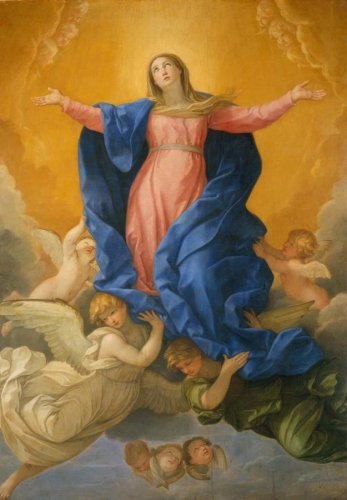
The Catholic Church proclaims a dogma, which is contemplated in the fourth glorious mystery, that the Virgin Mary was assumed body and soul into heavenly glory at the end of her earthly life. This belief is part of the treasury of the Roman Catholic Church, Eastern Orthodoxy, Oriental Orthodoxy, and parts of Anglicanism. Pope Pius XII dogmatically defined this doctrine in the Apostolic Constitution Munificentissimus Deus on November 1, 1950, while exercising the Papal magisterium. The evidence to this belief is found in texts that date back to as early as the 4th century all over Christendom. In the 5th century, the feast was part of the liturgy in the East, while it was celebrated in the West in the 8th century. Pope Leo IV gave official confirmation to the feast.
The scriptural support for the dogma is the Book of Genesis (3:15) wherein the text refers to Mary’s victory over sin and death. Also reflected in 1 Corinthians 15:54: “….Death is swallowed up in victory.” In this passage, St Paul alludes to Genesis 3:15 (in addition to the crucial reference to Psalms 8:6), where it is prophesied that the seed of the woman will crush Satan with his feet. Since, then, Jesus arose to Heaven on the third day after His death to fulfil this prophecy, it follows that the woman would have a similar end, since she shared this enmity with Satan.
Pope Pius XII also refers to the liturgical Psalm commemorating the return of the Ark of God to Jerusalem and mourning its subsequent loss (Psalm 132). The Psalm further illustrates that the loss will be rewarded in the New Covenant, and so it is hopefully prayed, “Arise, O Lord, into thy resting place: thou and the ark, which thou hast sanctified” (Ps 132:8). Since the Church sees this ark of the New Covenant in Mary, it recognizes that she was taken into Heaven in the same manner as Jesus. A reference made to Revelation (12:1–2), “Now a great sign appeared in heaven: a woman, robed with the sun, standing on the moon, and on her head, a crown of twelve stars” offers further support to the doctrine.
According to the Catechism of the Catholic Church, Mary did not suffer from original sin but was conceived full of grace. The angel Gabriel greets Mary, “Hail, full of grace,” (Luk 1:28) which indicates that Mary already has been filled with God’s grace, even before she conceived Jesus in her womb. Since Jesus is the manifestation of God Himself and the Second Person of the Trinity, the Church believes that he is worthy to dwell in a pure vessel - the holy temple. Thus, it is fitting that God would prepare Mary as an immaculate dwelling place, full of grace and untainted by sin.
Though Catechism teaches us that Mary was assumed into heaven at the end of her earthly life, the Church does not state whether her assumption took place after her death. Most of the theologians and saints throughout the Church history have affirmed that Mary did experience death — not as a penalty for sin, but in the consistency to her son, who willingly experienced death on our behalf. In view of this, John Paul II said “the Mother is not superior to the Son who underwent death, giving it a new implication and changing it into a means of salvation.”
One of the consequences of original sin is the corruption of the body (Gen 3:19). If Mary was full of grace and did not suffer from original sin, it is fitting that she, like her son Jesus, would not experience such bodily corruption.
Although no explicit proof in Scripture exists for Mary’s assumption, some biblical premise enlightens us on this doctrine. The notion of being taken up into heaven has some precedent in Scripture. Enoch was taken into heaven without seeing death (Heb 11:5), and Elijah was by a whirlwind into heaven by the chariots of fire at the end of his life (2 Kgs 2:11). If God could assume (a term derived from assumption) these righteous men of the Old Testament, it is certainly possible that Jesus could assume his own mother as well.
Since the Bible presents Mary as the first Christian disciple, it is appropriate that she would be the first to receive the blessings as a reward for following Christ. In the New Testament, Mary heard God’s voice through angel Gabriel and readily accepted God’s wish at the annunciation (Luk 1:38, 45). She responds to God’s word swiftly by going in haste to assist her cousin Elizabeth who had also conceived at an advanced age. She also describes herself as a servant of the Lord (Luk 1:38, 48).
She perseveres in faith throughout her life. She gathers with the apostles for prayer even after her son’s ascension (Acts 1:14). Thus, the New Testament clearly portrays Mary as the first and extraordinary disciple of Christ, who hears the word of God and keeps it in her heart.
Thus, Mary’s assumption, which flows from her unique participation in Christ’s victory as the mother of the Saviour and as the first and most faithful Christ’s follower, anticipates to some degree our own share in the fullness of that victory if we persevere as followers of Christ.
(The writer is a teacher Grade I at R & P Salkar HSS of Arts and Commerce, Chorão, and a catechist at St Michael church, Taleigão)